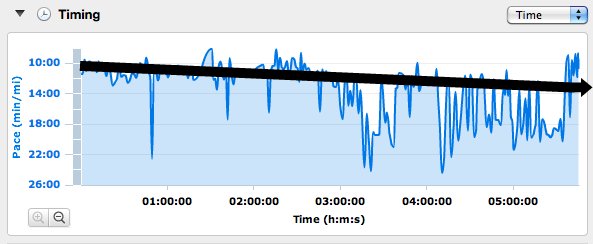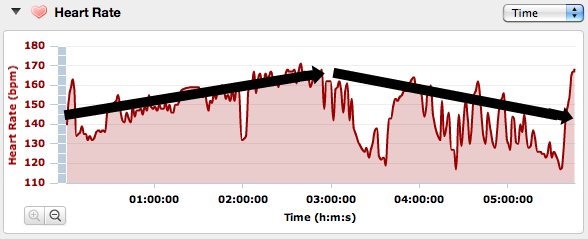Proper Marathon Pacing: Nail Your Start to Manage Your Heart Rate
After months of training and countless miles, your race is here. Hundreds of hours of hard work all come down to one day and 26.2 miles. Yet after juggling workouts and recovery, managing your commitments, and making nuanced adjustments to your nutrition, the most common race strategy is practically no strategy at all:
1 — determine your goal finishing time
2 — divide by 26.2 to get a per mile split.
3 — run that even pace until you blow up, burn out, or hit the finish line…whichever comes first.
Any veteran marathon runner will tell you that their race day splits look nothing at all like that neat little pace band they picked up in the expo. There are countless factors to contend with on race day: crowding, weather, and terrain just to name a few. And let’s not forget the biggest factor of all: YOU.
Simple vs Strategic
The pace band strategy is appealing because it’s so simple. All you have to worry about is running one simple split, over and over again, to meet the benchmarks and make your goal. Simple on paper, however, is not simple in reality.
At the start of the race you are excited and well-tapered; you have lots of energy. Contrast that with the end of the marathon, where most of us are on the ropes both physically and mentally. Somewhere between these two points is a happy middle ground that allows us to run well without making massive assumptions about our day and our fitness.
A strategic approach instead maps to how your body operates across the day. A good strategy allows you to conserve critical energy early, settle into a sustainable pace for the body of your race, and ideally sets you up to run the last few critical miles well.
That Which Doesn’t Kill Us…Makes Us Smarter!
We can learn a great deal about what we should do to by observing what we did that didn’t work. The two images at the top of this post show what happens when a running picks an overly aggressive pace for the full marathon distance.
As you can see from the blue chart, the overall pace degrades over time. The real decline starts just before the three hour mark. The runner regroups to run what might be a better pace for about 35 minutes (the 3:40 to 4:15 mark), but at this point even that’s too much. He chooses to use a run/walk strategy to keep moving forward, and by the end he’s buoyed by the finish line to finish with an effort that matches exactly how he started. In other words, his final “kick” was only as fast as he choose to run those first easy miles!
Our Running Plans Now Online at Endurance Nation!UltraDistance | Marathon Plans | Half Marathon Plans | 10k Plans | 5k Plans |
The Heart of the Matter
As the second chart shows above, this marathon runner’s real race isn’t against the clock, it’s against himself! The early aggressive pace he picked didn’t “show up” on his heart rate monitor as he was well-rested and tapered. Before long, however, he had gone from the low 140s to cracking 170 beats per minute…a 30-beat swing in under three hours on steady pacing! Yet another indicator that the initial pacing goal was simply too ambitious.
Over the course of the race, your heart rate will absolutely go up. It’s a function of continuing to exercise at a steady rate while your body uses up its energy stores and needs to continue delivering oxygen to your muscles as they fatigue and become less and less efficient. In other words, it takes more work to continue the same pace later in the day that was once so easy at the start.
In the case of our runner, the only way he could drop his heart rate to a more manageable level was to drop his pace…by walking. Great strategy for managing the heart rate issue; poor strategy for getting to the finish line quickly.
Here is the race in his own words:
I ran that race by attempting to run with the 5:00 hour pacer. I had a month old vDot from at 10k that would have put me at 4:20 so I didn’t think a 5 hour marathon was unreasonable. But if you compare my data to the pace Coach Patrick’s plan would have put me at it is easy to see why my marathon became a walk/run sufferfest around mile 16. On plan my first 6 miles would have been 11:42 when in reality, only 3 of my first 6 were over 11 and only one was close to the 11:42.
After the first 6 I would have been on plan at 11:22 and I was still faster, except for the pitstop in mile 11, until I hit mile 16. The next ten miles I would walk to get my heart rate down, then run because it hurt a little less than walking. At about my twenty my only goal was to save enough energy so the finishing photos would be of me running. As you can see, the minutes I saved (by running faster) in the first half did not go in a bank, they ultimately cost me 45 minutes on my overall time.
It’s Gotta be the Start
As the red chart reveals, you might not know you’ve made a poor choice until it’s too late. To fix this issues, we need a strategy that keeps us on track to meet our race goals and also takes the heart rate issue into account.
Proper early pacing can offset the damage that typical poor race execution yields. Starting the first three miles of a half marathon too hard means that our HR will continue to go up over time even if our pace declines (your body is working harder but your aren’t seeing the results). In fact, nothing short of walking will really help you get your HR back under control, and by that point you are no longer racing.
The savvy pace athlete starts off slightly slower, pegging a lower HR. She builds her effort into her race pace, not doing anything crazy to her muscles/body early on. She knows the marathon will get hard on its own, there’s no need to make things more complicated.
After the initial six mile period where her focus is on building her effort from very easy to slightly faster than goal average pace, she settles into steady state mode. All the rabbits are long gone, and she uses the next 14 miles to chip away at the extra time that her smart early pacing “cost” her. Thanks to her early pacing and now resultant lower Heart Rate, she is better able to process the critical calories and fluids that will help her through the latter stages of her day.
Just as her body starts to hurt around mile 20, she can wrap her head around “just” doing a 10k. After all, she’s only been really running for 14 miles — those first few easy miles are mentally “free.” It also helps that she is now passing lots of other folks, which helps her to stay focused and motivated.
Run to the Line; Race to the Finish
It’s the Marathon Nation motto, a value we work on instilling from the outset. Regardless of your speed or experience, anyone can have a great race if they execute well. The power of proper pacing is not in a killer last few miles of your race, but in the using restraint to conserve early energy to make the “meat” of our race, those middle miles, very consistent and powerful. When a race is executed properly the finishing kick is a function of your fitness and mental fortitude; both of which are much greater supply since you are no longer simply running hard from the gun and crossing your fingers.
Free Download
If you are looking for more detailed information on marathon pacing, please download and use our free race execution guide here.



8 Responses to “Proper Marathon Pacing: Nail Your Start to Manage Your Heart Rate”